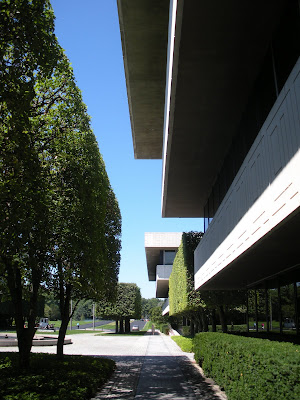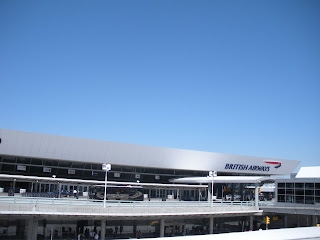 |
| --All photos ©2010, Ryan Witte, unless noted. |
In fact, the megalopolis theory of the northeast calls from the northern edge of Boston down to the southern tip of D.C. one enormous city. That is to say, if you were to drive from the northern end to the southern, you could quite literally never encounter any area more rural than a "suburb," which still has an "urb" in it.
Secondly, although a bit hot, the weather was glorious. I even got a tiny little bit of sunburn on my big, powerful, muscular shoulders. These are not the kind of excursions I'm going to want to make when the temperature is below zero and it's threatening to blizzard. So I can use the colder months to explore the sites that are closer and easier to visit.
As many of you know, Pepsi's move to the suburbs was part of the great corporate exodus at the end of the 1960s. General Foods and General Motors had already created suburban campuses. IBM, American Can, Bell Telephone, they were all looking to escape the cities. It was a bit unexpected in the case of PepsiCo, because they had only just finished their New York headquarters. The Purchase compound opened in 1970.
 I found it kind of amusing that in the vicinity of the headquarters, there are Pepsi signs and Pepsi vending machines and people selling Pepsi everywhere they could possibly do it.
I found it kind of amusing that in the vicinity of the headquarters, there are Pepsi signs and Pepsi vending machines and people selling Pepsi everywhere they could possibly do it.Wait a minute. I didn't even look at that when I was taking the picture. $3.75 for a twelve-ounce can of Pepsi??? That better be the best damn soda I've ever tasted in my life.
Ironically, I don't drink soda at all. About two or three times a year, I'll have a can of Coke just for the fun of it, but other than that, I don't do junk food. I wasn't raised on it as a kid, and as an adult, I just don't ever crave it, thankfully. I don't even particularly care for the taste of Pepsi, to be honest. And Mountain Dew (distributed by PepsiCo) is just disgusting. Whoever came up with that recipe must have been on drugs. I also don't think the dew on a mountain really tastes like that.
It's also interesting that I'm so addicted to Mad Men at the moment. I arrived a little late to the party because I don't have cable and watch everything online, but I watch another episode almost every evening and can't stop. [As of now, I'm all caught up.] The corporate suburban exodus rides right on the tails of the big business atmosphere depicted so lovingly by Mad Men. It definitely helped me to put this into its proper context.
Of course, I went primarily to see the architecture, because I'm a huge fan of Stone's work. I was also aware before making the trip that the grounds were beautiful and included an impressive collection of sculpture. What I discovered by being there in person completely transcended a mere collection of nice works of art and design. Instead, PepsiCo is three art forms--Landscape, Sculpture, and Architecture--seamlessly locked together in an endless dialogue of fascinating and perspicuous interrelationships. I've therefore decided to divide this story into those three discrete components, and look at how each responds to and interacts with the other two.
 |
| Google Maps view. |
It shouldn't come as much surprise that the landscaping is so perfectly matched with the architecture. Stone's own son not only most likely had a better knowledge of his father's work than anyone, but also just an intuitive understanding of what he's was trying to accomplish stylistically. Ed, Jr. passed away two years ago, but his firm still remains in business.
I'm sure it was incredible when it was first finished, but now that all the trees and plantings have had time to grow in and mature, it's like the Garden of Eden with so many wonderful moments of discovery. I'd come in through the front, but there on the right you can see the first view I had of the building after parking the car.
Then I walked around to the main entrance. As you can kind of see in the bird's eye view, and I'll discuss more later, the entrance is cruciform in shape with three courtyards off the main axis, one in front and one off to either side. I think I gasped out loud when I saw the courtyard at the center.

[From other photos I've seen, it's apparent that there's a fountain behind that tree on the left, but none of them were running that day, unfortunately.] The two courtyards on the sides don't have pools, but sunken gardens with flowers and sculptures. I told the security guard when I walked back out that it would be a bad place to work if you had allergies, but he just said "what," and didn't seem to have a very good sense of humor. It was true, you could really smell all the nature in there air quite vividly.
I was immediately struck by the way the sharply manicured rows of trees create all these incredibly complex geometric relationships with the building.


I thought the frame of trees around the courtyards was quite smart also.
They block the windows from view, giving the offices inside a measure of privacy. If you think about what you'd see looking out the windows, it's something green and natural, but it's a flat plane of greenery. It would be soothing, but not distracting.
In unbelievably striking contrast to the strict orderliness of the main entrance, the western corner of the building may as well have been by a different landscape architect altogether.
 Here you encounter a wildly naturalistic vibe. It's not completely disordered, either. I mean, you can see the design if you're paying attention and it was obviously planted with a purpose.
Here you encounter a wildly naturalistic vibe. It's not completely disordered, either. I mean, you can see the design if you're paying attention and it was obviously planted with a purpose. Nonetheless, there is the feeling while walking along that path that from a perfectly mowed lawn, you're suddenly encountering a small, isolated untamed moment before returning to civilization again.
Nonetheless, there is the feeling while walking along that path that from a perfectly mowed lawn, you're suddenly encountering a small, isolated untamed moment before returning to civilization again.And it's civilization with a vengeance, too. The rigid formality of the southwestern facade is most sobering, indeed.

It's the seriousness of this that makes the location of Joan Miró's Personnage so delightfully genius here, but I'll discuss that more in the next post. The sculptures were brought in after the landscaping had filled in, so they could be positioned just right. It shows.
Keep in mind that while in some places, there are ample opportunities to wander off the path, in others, your route is strictly controlled. This was one of them. Steep berms mostly prevent you from getting too close to the building in some cases (I didn't mind climbing them), controlling your view of it. In this case, plantings and a wall force you to descend a staircase and walk out away from the building quite a distance.
Then you turn back around and see this.

This was another part of the campus that took my breath away.
They were very proud of it, also; at the far end is a shady trellised pavilion that frames the view and shelters a bench where you can sit to admire it.
It was here that I became fully aware of how the landscaping matches the forms of the architecture so perfectly.
 While the lines are very precise and angular, quite synthetic, the water lilies were a brilliant touch, because it still feels so natural at the same time.
While the lines are very precise and angular, quite synthetic, the water lilies were a brilliant touch, because it still feels so natural at the same time.The dragonflies think so, too. I tried to get a picture of one of them, but it was too small and I knew the photo would never come out.
 I love how Personnage pokes his head up over the bushes to look at the garden.
I love how Personnage pokes his head up over the bushes to look at the garden.Hello there.
That totally made me laugh.

Keeping watch over the garden on the other side are stylized peacock topiaries.
There are surprisingly few topiaries on the property considering how manicured it is. In fact, these are the only ones I remember seeing.
These made me grin, too, though. Do these remind you of anything?


Maybe I'm just crazy. I still can't be sure whether or not that was intentional.
Then, after that cluster of activity, everything opens up onto this enormous, beautiful, lush green field.

 There on the left is Arnaldo Pomodoro's Triad, which was one of my favorite pieces in the PepsiCo collection, but I'll discuss it in the next installment.
There on the left is Arnaldo Pomodoro's Triad, which was one of my favorite pieces in the PepsiCo collection, but I'll discuss it in the next installment. It was so nice for me, a city dweller, to be on so much grass that I actually started running around--not to save time, but just for the pleasure of running.
It was so nice for me, a city dweller, to be on so much grass that I actually started running around--not to save time, but just for the pleasure of running. The glass enclosure at the back is a cafeteria, so outside it is the most delightful seating area shaded by two big blocks of manicured trees.
The glass enclosure at the back is a cafeteria, so outside it is the most delightful seating area shaded by two big blocks of manicured trees.As you can see, there were people seated there, so I wanted to be careful where I aimed my camera.
 But the terrace looks out over the lawn with a view of an enormous man-made lake at the southern end of the property.
But the terrace looks out over the lawn with a view of an enormous man-made lake at the southern end of the property.At one time, the lake had a tower of water shooting up out if the middle. I don't know if it's still there, but unfortunately it wasn't spraying that day.
Part 2.
©2010, Ryan Witte






























